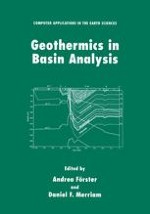1999 | OriginalPaper | Chapter
Problems and Potential of Industrial Temperature Data from a Cratonic Basin Environment
Authors : Andrea Förster, Daniel F. Merriam
Published in: Geothermics in Basin Analysis
Publisher: Springer US
Included in: Professional Book Archive
Activate our intelligent search to find suitable subject content or patents.
Select sections of text to find matching patents with Artificial Intelligence. powered by
Select sections of text to find additional relevant content using AI-assisted search. powered by
A thin veneer of clastic and carbonate sediments 460–1,375 m (1,500–4,500 ft) thick overlies a Precambrian crystalline basement complex in southeastern Kansas (Midcontinent, USA). Well-log temperatures were analyzed and related to modeled temperatures for different-size areas in a relatively simple structural setting of the shallow, cratonic Cherokee Basin. A statistical analysis of bottom-hole temperatures (BHTs) confirmed that (1) there is no significant change of temperature with season or through the 40 years of drilling and logging the wells in the area; and (2) the distribution of values is normal indicating they were recorded correctly on the rig within the instrumental precision of about 1 K. It was obvious from the large data set of nonequilibrium BHTs analyzed by depth and stratigraphic unit that they differed from drillstem test temperatures (DSTs) and modeled temperature- depth distributions based on heat conduction. At shallow depth (less than 500 m), BHT values as read from the logs are higher than ‘true’ formation temperature; in a depth range of 500–700 m, values scatter around a ‘true’ formation temperature; and at greater depths (up to 1,100 m), the uncorrected BHTs slightly underestimate the formation temperature. Different amounts of data scatter in the composite BHT-depth plots occur in different size areas, which also impacts the calculated geothermal gradients and empirical correction methods developed on the basis of these data. Although the BHTs in the 60×75 km area of Elk and Chautauqua counties scatter ±5–9°C around some mean value, seemingly the scatter can be reduced slightly when working with smaller areas, for example 10×10 km. A mapping approach made to investigate the variability of the 60×75-km BHT cluster in more detail showed part of the BHT scatter to be related to regional geology. Temperature residuals of the trend are on the order of ±2.5°C with some values as large as ±7.5°C. This provides an indication of variability of BHTs resulting from other influences, which might be different perturbations as a result of drilling practices and different shut-in times of the wells. In addition, some of the temperature highs are shown to be related to local, subtle anticlines developed in the sedimentary cover over faulted basement blocks and therefore contain signal. The separation of different effects on BHTs has implications on the reliability of geothermal gradient and heat-flow density estimations.
